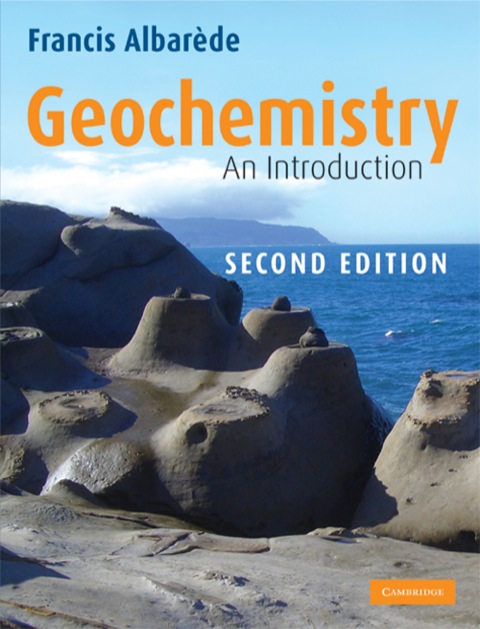Description
Efnisyfirlit
- Cover
- Half Title
- Title Page
- Copyright
- Contents
- Preface to the second edition
- Foreword to the first English edition
- Foreword to the French edition
- Acknowledgments
- Introduction
- 1. The properties of elements
- 1.1 The periodic table
- 1.2 Chemical bonding
- 1.3 States of matter and the atomic environment of elements
- 1.4 Geochemical classifications
- 1.5 The different reservoirs and their compositions
- 1.6 The nucleus and radioactivity
- Exercises
- 2. Mass conservation and elemental fractionation
- 2.1 Conservation of mass
- 2.2 Elemental fractionation
- 2.3 Films and interfaces
- 2.4 Distillation processes
- Exercises
- References
- 3. Fractionation of stable isotopes
- 3.1 Principles of stable isotope fractionation
- 3.2 Delta notation and stuff
- 3.3 Hydrogen
- 3.4 Oxygen
- 3.5 Carbon
- 3.6 Sulfur
- 3.7 Nitrogen
- 3.8 Other elements
- Exercises
- References
- 4. Geochronology and radiogenic tracers
- 4.1 Dating by radioactive nuclides
- 4.1.1 Carbon-14
- 4.1.2 Beryllium-10
- 4.1.3 The thorium-230 excess method
- 4.2 Systems with high parent/daughter ratios
- 4.2.1 The potassium–argon method
- 4.2.2 Dating zircons by the uranium–lead method
- 4.3 The isochron method
- 4.4 Radiogenic tracers
- 4.5 Helium isotopes
- Exercises
- References
- 5. Element transport
- 5.1 Advection
- 5.2 Diffusion
- 5.2.1 Closure temperature: chronometers, thermometers, and barometers
- 5.2.2 Other applications
- 5.3 Chromatography
- 5.4 Reaction rates
- 5.5 Adsorption
- Exercises
- References
- 6. Geochemical systems
- 6.1 Single-reservoir dynamics
- 6.2 Interaction of multiple reservoirs and geochemical cycles
- 6.3 Mixing and stirring
- Exercises
- References
- 7. The chemistry of natural waters
- 7.1 Basic concepts
- 7.2 Dominance diagrams
- 7.3 Speciation in solutions
- 7.4 Water–solid reactions
- 7.5 Electrolyte chemistry
- 7.6 Biological activity
- 7.7 The carbonate system
- 7.8 Precipitation, rivers, weathering, and erosion
- 7.9 Elements of marine chemistry
- Exercises
- References
- 8. Biogeochemistry
- 8.1 The geological record
- 8.2 Some specifics of biological activity
- 8.3 The chemistry of life
- 8.4 Biominerals
- 8.5 Biological controls on the ocean–atmosphere system
- 8.6 Diagenetic transformation of organic material
- 8.7 Biomarkers
- 8.8 Metals in organic matter
- References
- 9. Environments
- 9.1 Phanerozoic climates
- 9.1.1 Quaternary climates
- 9.1.2 Mesozoic and Cenozoic climatic trends
- 9.1.3 Biogeochemical catastrophes in the Phanerozoic
- 9.2 The rise of atmospheric oxygen
- 9.2.1 The 2.1 Ga crisis
- 9.2.2 The Snowball Earth and the emergence of Metazoans
- 9.3 The geochemical environment of the origin of life
- Exercises
- References
- 10. Mineral reactions
- 10.1 Early diagenesis
- 10.2 Hydrothermal reactions
- 10.3 Metamorphism
- 10.4 Water/rock ratios
- Exercises
- Reference
- 11. The solid Earth
- 11.1 The geochemical variability of magmas
- 11.1.1 Melting of the mantle and crust
- 11.1.2 Differentiation of magmatic series
- 11.2 Magmatism of the different tectonic sites
- 11.3 Mantle convection
- 11.4 The growth of continental crust
- References
- 12. The Earth in the Solar System
- 12.1 The formation of elements
- 12.2 The formation of the Solar System
- 12.3 Condensation of planetary material
- 12.4 The composition of the Earth and its core, and the origin of seawater
- 12.5 The early Solar System
- 12.6 The Moon
- 12.7 Mars
- 12.8 Venus
- 12.9 Planetary atmospheres
- Exercises
- References
- 13. The element barn
- 13.1 Silicon
- 13.2 Aluminum
- 13.3 Potassium
- 13.4 Sodium
- 13.5 Magnesium
- 13.6 Calcium
- 13.7 Iron
- 13.8 Sulfur
- 13.9 Phosphorus
- 13.10 Carbon
- References
- Appendix A: Composition of the major geological units
- Appendix B: The mixing equation for ratios
- Appendix C: A refresher on thermodynamics
- Appendix D: The geological time scale
- Appendix E: An overview of analytical methods
- Appendix F: Physical and geophysical constants
- Appendix G: Some equations relative to residence time
- Appendix H: The adiabatic atmosphere
- Further reading
- Index







Reviews
There are no reviews yet.